The ultra-low temperature air source heat pump units market is projected to grow from USD 849.0 million in 2025 to USD 1,232.7 million by 2035, supported by rising demand for high-efficiency heating solutions capable of reliable performance in cold climate conditions. During the first half of the forecast period, the market increases to approximately USD 1,023.0 million by 2030, adding USD 174.0 million and accounting for 45 percent of the decade’s total growth. This stage is driven by building operators and residential users seeking to reduce reliance on fossil fuel heating and lower operational costs amid increasing energy price volatility. The improved vapor compression cycles and refrigerant formulations used in ultra-low temperature systems enable stable heat output even at sub-zero ambient temperatures, making them suitable for northern regions and high-altitude settings.
From 2030 to 2035, the market expands by an additional USD 209.7 million, representing 55% of total growth. This phase is shaped by broader penetration into commercial real estate, district heating retrofits, and integration with building energy management systems. Smart control platforms, predictive performance optimization, and hybrid heat pump configurations are expected to gain traction as users prioritize lifecycle efficiency, reliable comfort output, and heating decarbonization targets.
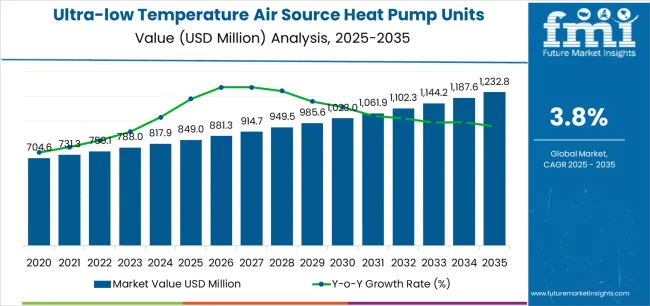
| Period | Primary Revenue Buckets | Share | Notes |
|---|---|---|---|
| Today | New unit sales (small, medium, large) | 56% | Capex-led, building-driven purchases |
| Replacement and retrofit | 22% | Unit upgrades, system modernization | |
| Service and maintenance | 14% | Preventive maintenance, repair services | |
| Parts and accessories | 8% | Compressors, controls, refrigerants | |
| Future (3-5 yrs) | Smart heat pump systems | 50-54% | IoT-enabled units, grid integration |
| Energy-as-a-service models | 18-22% | Performance guarantees, outcome-based pricing | |
| Installation and integration | 14-18% | Professional installation, BMS connectivity | |
| Maintenance subscriptions | 10-14% | Predictive maintenance, uptime guarantees | |
| Digital energy management | 6-8% | Load optimization, demand response | |
| Data services (energy analytics) | 4-6% | Performance benchmarking for building operators |
| Metric | Value |
|---|---|
| Market Value (2025) | USD 849.0 million |
| Market Forecast (2035) | USD 1,232.7 million |
| Growth Rate | 3.8% CAGR |
| Leading Technology | Small and Medium Sized Units |
| Primary Application | Commercial Segment |
The market demonstrates strong fundamentals with small and medium sized units capturing a dominant share through advanced efficiency features and commercial building optimization. Commercial applications drive primary demand, supported by increasing energy efficiency requirements and operational cost reduction needs. Geographic expansion remains concentrated in developed markets with established HVAC infrastructure, while emerging economies show accelerating adoption rates driven by building modernization initiatives and rising energy standards.
Primary Classification: The market segments by unit size into small and medium sized units and large units, representing the evolution from basic heating equipment to sophisticated climate control solutions for comprehensive building heating optimization.
Secondary Classification: Application segmentation divides the market into commercial, residential, and industrial sectors, reflecting distinct requirements for heating capacity, operational efficiency, and building standards.
Regional Classification: Geographic distribution covers North America, Latin America, Western Europe, Eastern Europe, East Asia, South Asia Pacific, and Middle East & Africa, with developed markets leading adoption while emerging economies show accelerating growth patterns driven by building infrastructure expansion programs.
The segmentation structure reveals technology progression from standard heating equipment toward sophisticated climate systems with enhanced low-temperature performance and energy capabilities, while application diversity spans from commercial buildings to industrial facilities requiring reliable heating solutions.

Market Position: Small and Medium Sized Units command the leading position in the ultra-low temperature air source heat pump units market with 64% market share through advanced heating features, including superior cold-weather performance, operational efficiency, and commercial building optimization that enable facility operators to achieve optimal heating consistency across diverse commercial and residential environments.
Value Drivers: The segment benefits from building operator preference for versatile heating systems that provide consistent thermal performance, reduced energy consumption, and installation flexibility without requiring significant infrastructure modifications. Advanced design features enable wide capacity range, modular configuration, and integration with existing HVAC equipment, where energy performance and reliability represent critical facility requirements.
Competitive Advantages: Small and Medium Sized Units differentiate through proven cold-weather reliability, consistent heating characteristics, and integration with building management systems that enhance facility effectiveness while maintaining optimal comfort standards suitable for diverse commercial and residential applications.
Key market characteristics:
Large Units maintain a 36% market position in the ultra-low temperature air source heat pump units market due to their high capacity properties and centralized heating advantages. These systems appeal to facilities requiring substantial heating loads with comprehensive climate control for large commercial and industrial applications. Market growth is driven by building modernization, emphasizing reliable heating solutions and energy efficiency through optimized system designs.
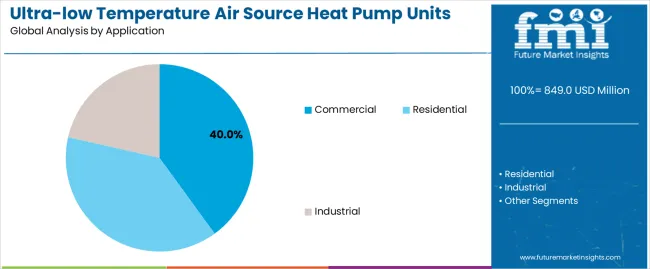
Market Context: Commercial applications exhibit the highest growth rate in the ultra-low temperature air source heat pump units market, capturing a 40% market share. This growth is driven by the widespread adoption of sustainable heating systems and a growing focus on energy cost reduction, operational efficiency, and building sustainability goals that maximize energy savings while maintaining comfort standards.
Appeal Factors: Commercial building operators prioritize system reliability, energy efficiency, and integration with existing building infrastructure that enables coordinated climate control across multiple zones. The segment benefits from substantial energy efficiency investment and building modernization programs that emphasize the acquisition of heat pump systems for heating optimization and cost efficiency applications.
Growth Drivers: Green building programs incorporate ultra-low temperature heat pumps as standard equipment for heating operations, while energy regulation compliance increases demand for efficient heating capabilities that meet environmental standards and minimize operational costs.
Market Challenges: Varying building specifications and installation complexity may limit system standardization across different facilities or climate scenarios.
Application dynamics include:
Residential applications capture a 35% market share, driven by increasing demands in single-family homes, multi-family buildings, and residential complexes. These applications require reliable heating systems that can operate in extreme cold while ensuring effective comfort and energy efficiency.
Industrial applications account for 20% of the market share, covering manufacturing facilities, warehouses, and production environments. These applications require process heating and space conditioning capabilities to optimize operations and manage energy effectively.
| Category | Factor | Impact | Why It Matters |
|---|---|---|---|
| Driver | Energy efficiency regulations and decarbonization targets (net-zero buildings) | ★★★★★ | Requires electrified heating solutions with low emissions for building operations achieving sustainability goals across installations. |
| Driver | Rising energy costs and fuel price volatility (fossil fuel alternatives) | ★★★★★ | Turns efficient heat pumps from optional to mandatory; vendors providing lifecycle cost analysis and energy savings gain competitive advantage. |
| Driver | Cold climate technology advancement (enhanced refrigerants, improved defrost) | ★★★★☆ | Manufacturers need reliable cold-weather performance; demand for validated low-temperature operation expanding addressable market. |
| Restraint | High initial investment and payback period concerns | ★★★★☆ | Small building owners defer purchases; increases financing needs and slows adoption in cost-sensitive markets. |
| Restraint | Installation complexity and skilled labor shortage | ★★★☆☆ | Technical installation requirements and contractor training limiting market penetration in certain regions. |
| Trend | Smart controls and grid integration | ★★★★★ | Demand response capability, load shifting, and energy management transform operations; connectivity becomes core value proposition. |
| Trend | Renewable energy integration and hybrid systems | ★★★★☆ | Solar PV pairing and thermal storage; multi-source heating systems drive competition toward flexible solutions. |
The ultra-low temperature air source heat pump units market demonstrates varied regional dynamics with Growth Leaders including China (5.1% growth rate) and India (4.8% growth rate) driving expansion through building modernization initiatives and infrastructure development. Steady Performers encompass Germany (4.4% growth rate), United States (3.6% growth rate), and developed regions, benefiting from established HVAC industries and advanced energy efficiency adoption. Emerging Markets feature Brazil (4.0% growth rate) and developing regions, where building initiatives and energy efficiency programs support consistent growth patterns.
Regional synthesis reveals East Asian markets leading adoption through construction expansion and energy efficiency development, while North American countries maintain steady expansion supported by building technology advancement and decarbonization requirements. European markets show moderate growth driven by heating applications and sustainability integration trends.
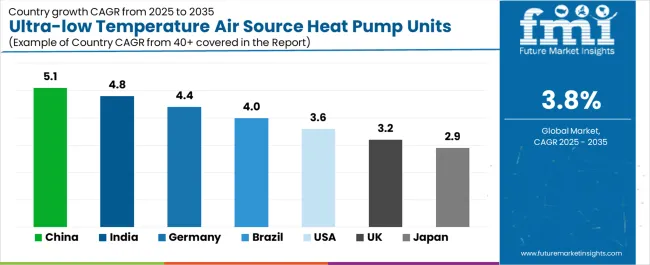
| Region/Country | 2025-2035 Growth | How to win | What to watch out |
|---|---|---|---|
| China | 5.1% | Lead with cost-effective systems | Policy changes; technology standards |
| India | 4.8% | Focus on commercial partnerships | Infrastructure gaps; awareness levels |
| Germany | 4.4% | Offer premium efficiency systems | Subsidy changes; installation capacity |
| USA | 3.6% | Provide retrofit solutions | Regulation variations; gas competition |
| Brazil | 4.0% | Value-oriented products | Economic volatility; import duties |
| UK | 3.2% | Push net-zero solutions | Heat pump readiness; grid capacity |
| Japan | 2.9% | Focus on cold-climate performance | Conservative adoption; high standards |
China establishes fastest market growth through aggressive building electrification programs and comprehensive heating infrastructure development, integrating advanced ultra-low temperature air source heat pumps as standard equipment in commercial building and district heating installations. The country's 5.1% growth rate reflects government initiatives promoting clean heating and domestic HVAC capabilities that mandate the use of efficient heat pumps in northern regions and commercial facilities. Growth concentrates in major urban centers, including Beijing, Tianjin, and Shenyang, where heating technology development showcases integrated heat pump systems that appeal to building operators seeking advanced efficiency capabilities and clean heating applications.
Chinese manufacturers are developing cost-effective heat pump solutions that combine domestic production advantages with advanced heating features, including ultra-low temperature operation and smart controls. Distribution channels through HVAC equipment suppliers and building service distributors expand market access, while government support for clean heating supports adoption across diverse commercial and residential segments.
Strategic Market Indicators:
In Delhi, Mumbai, and Bangalore, commercial buildings and industrial facilities are implementing advanced ultra-low temperature air source heat pumps as standard equipment for climate control and energy efficiency applications, driven by increasing government energy efficiency investment and building modernization programs that emphasize the importance of sustainable heating capabilities. The market holds a 4.8% growth rate, supported by government energy initiatives and building infrastructure development programs that promote efficient heat pumps for commercial and industrial facilities. Indian operators are adopting heat pump systems that provide consistent heating performance and energy efficiency features, particularly appealing in northern regions where winter heating and energy costs represent critical operational requirements.
Market expansion benefits from growing commercial construction capabilities and international technology partnerships that enable domestic production of advanced heat pump systems for building applications. Technology adoption follows patterns established in HVAC equipment, where efficiency and performance drive procurement decisions and building deployment.
Market Intelligence Brief:
Germany establishes energy efficiency leadership through comprehensive building decarbonization programs and advanced heating technology development, integrating ultra-low temperature air source heat pumps across commercial and residential applications. The country's 4.4% growth rate reflects established building industry relationships and mature energy efficiency technology adoption that supports widespread use of heat pumps in retrofit and new construction facilities. Growth concentrates in major urban regions, including North Rhine-Westphalia, Bavaria, and Baden-Wurttemberg, where heating technology showcases mature heat pump deployment that appeals to building operators seeking proven efficiency capabilities and decarbonization applications.
German equipment providers leverage established distribution networks and comprehensive technical support capabilities, including energy efficiency certification programs and installation training that create customer relationships and operational advantages. The market benefits from mature building standards and decarbonization requirements that mandate efficient heating use while supporting technology advancement and energy optimization.
Market Intelligence Brief:
United States establishes building electrification leadership through comprehensive energy efficiency programs and advanced building infrastructure development, integrating ultra-low temperature air source heat pumps across commercial and residential applications. The country's 3.6% growth rate reflects established HVAC industry relationships and growing electrification technology adoption that supports increasing use of heat pumps in cold-climate regions. Growth concentrates in northern states, including New York, Massachusetts, and Minnesota, where heating technology showcases expanding heat pump deployment that appeals to building operators seeking energy efficiency capabilities and fossil fuel alternatives.
American equipment providers leverage established distribution networks and comprehensive technical support capabilities, including energy rebate programs and contractor training that create customer relationships and operational advantages. The market benefits from evolving building codes and electrification incentives that support heat pump adoption while promoting technology advancement and energy optimization.
Market Intelligence Brief:
Brazil's market expansion benefits from diverse climate control demand, including commercial development in Sao Paulo and Porto Alegre, building facility upgrades, and government energy programs that increasingly incorporate efficient heating solutions for climate control applications. The country maintains a 4.0% growth rate, driven by rising commercial construction activity and increasing recognition of heat pump technology benefits, including energy efficiency and operational cost reduction.
Market dynamics focus on cost-effective heat pump solutions that balance advanced heating performance with affordability considerations important to Brazilian building operators. Growing commercial development creates continued demand for modern heating systems in new building infrastructure and facility modernization projects.
Strategic Market Considerations:
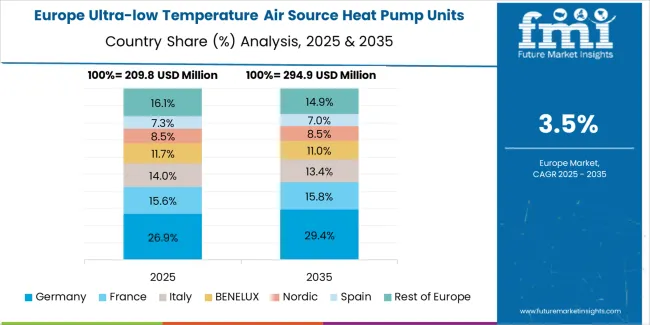
The ultra-low temperature air source heat pump units market in Europe is projected to grow from USD 318.0 million in 2025 to USD 461.0 million by 2035, registering a CAGR of 3.7% over the forecast period. Germany is expected to maintain its leadership position with a 34.6% market share in 2025, supported by its advanced building decarbonization infrastructure and major heating technology centers.
United Kingdom follows with a 23.8% share in 2025, driven by comprehensive net-zero programs and heat pump deployment initiatives. France holds a 19.4% share through specialized building applications and energy efficiency requirements. Italy commands a 12.2% share, while Spain accounts for 10.0% in 2025. The rest of Europe region is anticipated to gain momentum, expanding its collective share from 5.4% to 6.2% by 2035, attributed to increasing heat pump adoption in Nordic countries and emerging building facilities implementing heating modernization programs.
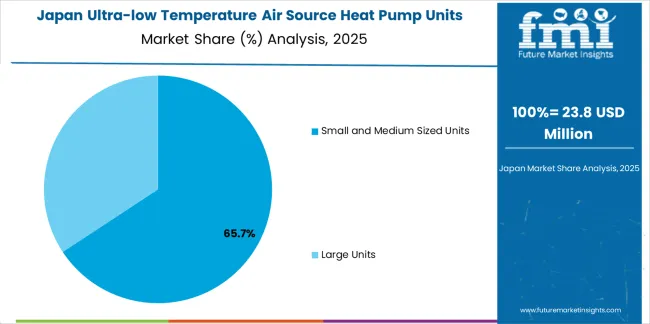
Japan's ultra-low temperature air source heat pump units market benefits from established HVAC manufacturing excellence and comprehensive quality standards. The country maintains a 2.9% growth rate, supported by government initiatives promoting energy efficiency and heating technology advancement. Major urban centers in Hokkaido, Tokyo, and Tohoku showcase advanced heat pump deployment for residential applications and commercial buildings. Japanese manufacturers prioritize system reliability and cold-weather performance, creating demand for premium units with superior efficiency and environmental resistance. Distribution channels through established HVAC equipment networks enable broad market access across residential and commercial segments.
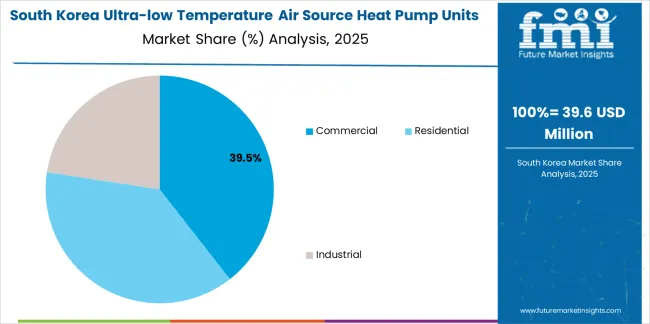
South Korea's market expansion reflects advanced building technology infrastructure and comprehensive energy efficiency programs. The country demonstrates strong adoption of efficient heat pump systems in residential and commercial buildings across Seoul, Busan, and Incheon. Growth is driven by building modernization initiatives and increasing focus on heating electrification standards. Korean building facilities emphasize integrated heating solutions with smart control compatibility and energy management capabilities. Market development benefits from government energy efficiency investment programs and established HVAC manufacturing capabilities supporting domestic production of advanced heat pump systems.
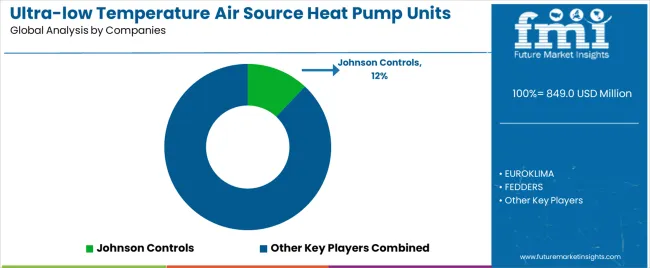
The ultra-low temperature air source heat pump units market maintains a moderately fragmented structure with 20-25 credible players, where the top 5-7 companies hold approximately 48-54% by revenue. Market leadership is maintained through technical expertise networks, service capabilities, and product innovation encompassing compressor technology, refrigerant optimization, and control system advancement. Competition centers on cold-weather performance, energy efficiency, and integration with building workflows including automation systems and energy management platforms.
Basic heat pump designs and standard efficiency units are commoditizing, shifting competitive advantage toward advanced features such as enhanced low-temperature operation, smart controls, and comprehensive service offerings. Margin opportunities concentrate in installation services, maintenance contracts, and integration into building workflows with energy optimization and demand response programs. Leading manufacturers differentiate through extensive cold-climate testing data supporting performance claims, comprehensive contractor training programs, and responsive service networks reducing system downtime.
The competitive landscape features global HVAC manufacturers leveraging broad distribution networks and established building industry relationships, specialized heat pump companies focusing on cold-climate innovation and application expertise, regional HVAC suppliers providing localized support and competitive pricing, and emerging smart technology providers introducing IoT connectivity and energy analytics. Strategic partnerships between heat pump manufacturers and utility companies are increasing, enabling demand response programs and expanding addressable markets beyond traditional building heating into grid flexibility and energy storage sectors.
Market dynamics favor participants with proven cold-weather validation, comprehensive service networks, and ability to demonstrate energy savings performance. Technology refresh cycles accelerate as smart controls and ultra-low temperature capability become standard expectations, while energy efficiency certifications and building code compliance create barriers to entry protecting established players. Pricing pressure emerges in moderate-climate applications, while premium positioning remains viable for manufacturers offering comprehensive technical solutions with demonstrated cold-climate performance and integration capabilities supporting building decarbonization initiatives.
| Item | Value |
|---|---|
| Quantitative Units | USD 849 million |
| Unit Size | Small and Medium Sized Units, Large Units |
| Application | Commercial, Residential, Industrial |
| Regions Covered | North America, Latin America, Western Europe, Eastern Europe, East Asia, South Asia Pacific, Middle East & Africa |
| Countries Covered | United States, China, Germany, India, United Kingdom, Japan, Brazil, France, South Korea, Canada, and 20+ additional countries |
| Key Companies Profiled | Johnson Controls, EUROKLIMA, FEDDERS, Midea, Haier, Carrier, Guangzhou H.Stars Refrigerating Equipment, Nanjing Tica Climate Solutions |
| Additional Attributes | Dollar sales by unit size and application categories, regional adoption trends across East Asia, South Asia Pacific, and North America, competitive landscape with HVAC manufacturers and building equipment suppliers, building operator preferences for energy efficiency and cold-weather performance, integration with building management platforms and energy control systems, innovations in refrigerant technology and defrost control, and development of smart heat pump solutions with enhanced low-temperature performance and building optimization capabilities. |
The global ultra-low temperature air source heat pump units market is estimated to be valued at USD 849.0 million in 2025.
The market size for the ultra-low temperature air source heat pump units market is projected to reach USD 1,232.8 million by 2035.
The ultra-low temperature air source heat pump units market is expected to grow at a 3.8% CAGR between 2025 and 2035.
The key product types in ultra-low temperature air source heat pump units market are small and medium sized units and large units.
In terms of application, commercial segment to command 40.0% share in the ultra-low temperature air source heat pump units market in 2025.






Full Research Suite comprises of:
Market outlook & trends analysis
Interviews & case studies
Strategic recommendations
Vendor profiles & capabilities analysis
5-year forecasts
8 regions and 60+ country-level data splits
Market segment data splits
12 months of continuous data updates
DELIVERED AS:
PDF EXCEL ONLINE
Ultra-Low Temperature Perfluoroelastomer Market Size and Share Forecast Outlook 2025 to 2035
Ultra-Low Temperature Freezers Market Size and Share Forecast Outlook 2025 to 2035
Temperature Controlled Pharmaceutical Packaging Solutions Market Forecast and Outlook 2025 to 2035
Temperature Monitoring Device Market Size and Share Forecast Outlook 2025 to 2035
Temperature Controlled Vaccine Packaging Market Size and Share Forecast Outlook 2025 to 2035
Temperature and Freshness Sensors Market Size and Share Forecast Outlook 2025 to 2035
Temperature Detection Screen Market Size and Share Forecast Outlook 2025 to 2035
Temperature Loggers Market Size, Share & Forecast 2025 to 2035
Temperature Controlled Pharma Packaging Market Size, Share & Forecast 2025 to 2035
Temperature Controlled Packaging Solution Market - Size, Share, and Forecast Outlook 2025 to 2035
Temperature Transmitter Market Growth - Trends & Forecast 2025 to 2035
Market Share Breakdown of Temperature Controlled Packaging Solutions
Temperature Sensors Market Growth - Trends & Forecast 2025 to 2035
Temperature Controlled Pharmaceutical Container Market Analysis, Size, Share & Forecast 2024 to 2034
Temperature Controlled Packaging Boxes Market
Temperature Sensing Foley Catheter Market
Temperature Calibrator Market
5G Temperature-Compensated Crystal Oscillator (TCXO) Market Size and Share Forecast Outlook 2025 to 2035
Low Temperature Flexible Tester Market Size and Share Forecast Outlook 2025 to 2035
Low-Temperature Cable Market Size and Share Forecast Outlook 2025 to 2035

Thank you!
You will receive an email from our Business Development Manager. Please be sure to check your SPAM/JUNK folder too.
Chat With
MaRIA